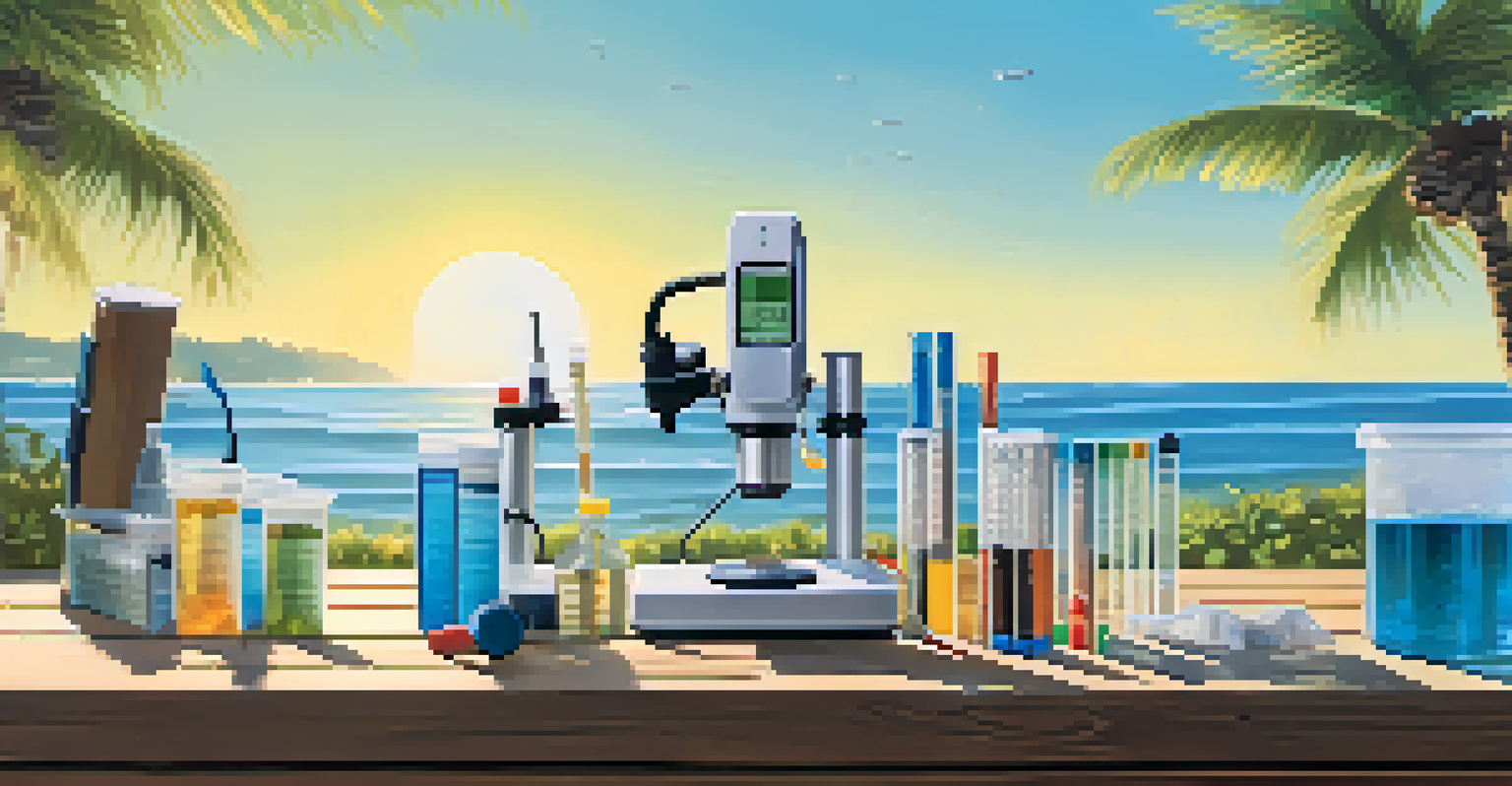How to Conduct Water Quality Testing at Santa Monica Beaches

Understanding the Importance of Water Quality Testing
Water quality testing is crucial for ensuring the safety and health of beachgoers. At Santa Monica beaches, where families and tourists flock, understanding the quality of the water can prevent health hazards like swimming in contaminated water. Regular testing helps maintain the beach's reputation as a safe recreational area.
Water is the driving force of all nature.
The ocean can be affected by various factors, including stormwater runoff, sewage spills, and natural events. By testing the water, we can detect harmful bacteria and pollutants that could pose risks to public health. Monitoring water quality also supports local wildlife and ecosystem health, ensuring that the beach remains a vibrant habitat.
Moreover, water quality information empowers the community to make informed decisions. When people are aware of the current conditions, they can enjoy their time at the beach with a peace of mind, knowing they are swimming in clean, safe waters.
Gathering Necessary Equipment and Supplies
Before heading to the beach, it’s essential to gather all the necessary equipment for water quality testing. This includes a water sampling kit, which typically contains bottles for collecting samples, a thermometer, and pH strips. These tools will help you accurately assess the water's condition.

You may also want to bring along a portable turbidity meter to measure water clarity, as well as a dissolved oxygen meter if you’re interested in assessing aquatic life health. Having a notebook or digital device for recording your findings is also helpful. Make sure all your equipment is clean and ready to use to avoid contamination.
Importance of Water Testing
Regular water quality testing is essential for ensuring the safety of beachgoers and protecting local ecosystems.
Lastly, consider checking local guidelines for any specific requirements or tools recommended by environmental agencies. Some organizations may even provide free testing kits, promoting community involvement in water quality monitoring.
Choosing the Right Time and Location for Testing
Timing is key when conducting water quality tests. It’s best to test after a significant rainfall, as this can lead to increased runoff and potential contamination. However, testing during dry periods is also important for establishing baseline conditions.
The health of our waters is the principle measure of how we live on the land.
When selecting a location, focus on areas where people frequently swim or where stormwater drains into the ocean. These spots are more likely to have varying water quality due to pollution sources. Additionally, consider testing at multiple points along the beach to gather comprehensive data.
Remember that some locations may have designated testing areas monitored by local agencies. It’s beneficial to coordinate with these organizations to compare your results with theirs for a deeper understanding of water quality trends.
Collecting Water Samples Safely and Effectively
When it’s time to collect your water samples, ensure you do so with care to avoid contamination. Begin by rinsing your sampling bottles with the water you are about to collect. This practice helps ensure that no harmful substances from previous samples affect your results.
Submerge the bottle below the surface to collect the water, ideally about 12 inches deep, as this is where the water is typically less influenced by surface debris. Close the bottle tightly and label it with the location and time of collection.
Safe Sampling Techniques
Collecting water samples carefully and accurately is crucial to avoid contamination and ensure reliable results.
After sampling, store the bottles in a cooler to maintain their temperature until you can analyze them. Prompt analysis is crucial as water quality can change quickly, especially in coastal areas.
Conducting Basic Water Quality Tests
Once you have collected your samples, it’s time to perform some basic water quality tests. Start by measuring the temperature, as warmer waters can promote bacterial growth. Use a thermometer to get an accurate reading.
Next, check the pH level with your pH strips. Most marine environments should have a pH between 7.5 and 8.5. If the pH is significantly outside this range, it could indicate pollution or other environmental issues.
Finally, assess turbidity, which indicates how clear the water is. High turbidity can signal the presence of pollutants or sediment, affecting both human health and marine life. Keeping track of these readings over time can reveal trends in water quality.
Interpreting Your Water Quality Results
Interpreting your water quality results can seem daunting, but it’s all about understanding what the numbers mean. If your temperature, pH, and turbidity readings fall within the typical ranges, the water is likely safe for recreational use.
However, if you notice elevated levels of bacteria or significant deviations in pH, it’s essential to report your findings to local health authorities. They can take further action, such as issuing warnings or closing certain areas of the beach to protect public health.
Community Involvement Matters
Engaging in ongoing water quality monitoring fosters a sense of responsibility and helps advocate for cleaner, safer beaches.
Remember, your findings contribute to a larger picture of water quality in Santa Monica. Sharing your results with local organizations can help the community stay informed and advocate for cleaner water.
Reporting Your Findings to Local Authorities
After analyzing your results, it’s vital to report them to local environmental or health authorities. This step ensures that your findings are documented and can be acted upon if necessary. Many agencies rely on community input to maintain accurate water quality records.
When reporting, include all relevant information such as testing location, time, and the specific results you obtained. Clear communication helps authorities understand the significance of your findings and take appropriate action.

Consider reaching out to local beach clean-up organizations as well. They may be able to use your data to promote awareness and encourage community efforts to improve water quality in the area.
Getting Involved in Ongoing Water Quality Monitoring
Getting involved in ongoing water quality monitoring can be both rewarding and impactful. Many organizations offer volunteer opportunities for community members to participate in regular testing. This involvement helps ensure the beach remains safe and clean for everyone.
Participating in these programs allows you to learn more about the local ecosystem and the challenges it faces. It’s a fantastic way to connect with like-minded individuals who share a passion for environmental conservation.
Moreover, being part of a community effort fosters a sense of responsibility and stewardship for local waters. Together, we can advocate for cleaner beaches and healthier oceans, making Santa Monica a safer place for everyone.